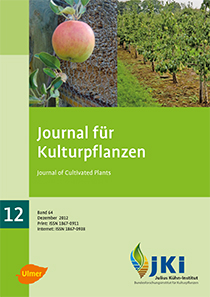Bioavailable copper and other heavy metal contents in organically and conventionally managed German vineyard, hop and pomiculture soils. Part 5: – Determination of bioavailable contents of copper and other heavy metals by CaCl2-extraction
Keywords:
Copper, bioavailability, vine, hop, pomiculture, Plasmopara viticola, Pseudoperonospora humuli, Venturia ssp., Nectria galligena, load distribution, risk potential, exposure assessment, selection of monitoring areasAbstract
Objective of the examinations is to indentify relations between bioavailable copper contents in vineyard, hop and pomiculture soils and management or natural factors.
A good correlation (r = 0,72–0,81) between bioavailable and total copper contents could not be verified. In addition medium-weak relations of bioavailable copper and duration of cultivation, pH and organic substance in the soil could be demonstrated. These relations prove that the availability of copper depends on a variety of pedological, ecological and cultivation related influences not allowing an exposure assessment for groups of soil organisms relevant for a sustainable culture by using a specific extraction method.
Investigations took place in preliminary studies of biological status report with collected soil samples covering characteristic vine, hop and pomiculture areas to determine the for earthworms available parts of copper and other heavy metals by CaCl2 extraction resulted in following conclusions:
a) By CaCl2 extraction determined soluble copper portion becomes part in the valuation matrix for the selection of areas which representing specific requirements for a biological sampling on species abundance of lumbricidae as an instrument of risk assessment for soil dwelling organisms. By it will be guarantee the comparability obtained data from long time cultivated vine areas with topical studies of the COPPER TASK FORCE in grassland.
b) It will be up to additional specific chemical and biological investigations to identify the main factors (e.g. soil history, soil and plant protection management or culturing techniques) responsible for the extent of bioavailability, and to quantify their impact e.g.
–Connection of applied copper containing plant protection residues with main fractions of soil,
–Which factors influenced the biodiversity and a postulated adaptability to concrete load situations under field conditions?
DOI: 10.5073/JfK.2012.12.02, https://doi.org/10.5073/JfK.2012.12.02








